1. Introduction
 Low noise fans and CPU heatsinks, even low noise storage drives have become the rage computer hardware. Today's end users prefer a silent solution and rightly so, be it for a 12cm case fan or an adjustable power supply. In the following pages, we will be reviewing Asus' latest addition to the "silent" movement, the N6600GT Silencer PCI-E model.
Low noise fans and CPU heatsinks, even low noise storage drives have become the rage computer hardware. Today's end users prefer a silent solution and rightly so, be it for a 12cm case fan or an adjustable power supply. In the following pages, we will be reviewing Asus' latest addition to the "silent" movement, the N6600GT Silencer PCI-E model.
The main difference between the Silencer and the previous N6600GT models is of course the fanless, heatsink design and the available memory, with the Silencer providing 256 M of DDR3 while the previous model only had 128Mb. There is a slight difference in the core and memory clocks but not one worth investigating.
Throughout the review tests, we will be posting the results of the Silencer 6600GT in comparison with those of the N6600GT Extreme PCI-E interfaced card.
- Specifications
| Graphics Engine |
GeForce 6600GT |
| Video Memory |
256 M DDR3 |
| Engine Clock |
500MHz |
| Memory Clock |
1GHz (500MHz DDR3) |
| RAMDAC |
400MHz |
| Bus Standard |
PCI-Express |
| Memory Interface |
128-bit |
| Max Resolution |
2048x1536 |
| VGA Output |
Standard 15-pin D-sub |
| TV Output |
HDTV-out |
| DVI Output |
DVI-I |
| 2nd VGA Output |
Yes |
| Adaptor/Cable Bundled |
HDTV out adaptor |
| DVI-to-2nd VGA adaptor |
| Software Bundled |
Joint Opts |
| ASUS DVD XP |
| Power Director |
| Media Show |
| ASUS Utilities & Drivers |
-Features
 - NVIDIA® CineFX™ 3.0 engine
- NVIDIA® CineFX™ 3.0 engine
Full support for Microsoft DirectX9.0 Shader model 3.0 enables stunning and complex special effects
- NVIDIA SLI Multi-GPU ready
Dramatically scales performance by allowing two graphics card to be run in parallel.
- High-Speed GDDR3 memory interface
Support for the world's fastest GDDR3 memory delivers fluid frame rates for even the most advanced games and applications.
- NVIDIA UltraShadow™ II technology
Enhances the performance of bleeding-edge games
- NVIDIA® Intellisample™ 3.0 technology (HCT)
The industry's fastest antialiasing delivers ultra-realistic visuals, with no jagged edges, at lightning-fast speeds
- NVIDIA® nView™ multi-display technology
Provides the ultimate in viewing flexibility and control for multiple monitors
- Microsoft® DirectX 9 and OpenGL 1.5 support
 - Asus SilentCool Technology provides the quietest environment and superior Cooling effect.
- Asus SilentCool Technology provides the quietest environment and superior Cooling effect.
- ASUS Splendid : Bring Every Pixel To Life. Watching video on PCs is now as good as on the best TVs.
- ASUS GameFace ™ Messenger : Don ' t Type, Just Talk. Easy IM & live game conference in any PC games
- ASUS GameLiveShow : Stream live gaming action onto the Internet and share with other gaming enthusiasts.
- ASUS GameReplay : Record gaming action and strategy into MPEG4 files to share with other gaming enthusiasts.
- ASUS Video Security™ Online: Whether you're online or not, ASUS VideoSecurity Online provides you a flexible and economical security system. It can easily turn your computer into your own security server.
- ASUS OnScreenDisplay (OSD): OSD allows you to instantly adjust various display settings in almost any PC game without leaving the game.
- Diversified displays connectivity (DVI, VGA, DVI+VGA, DVI+TV-out)
- High-quality TV output for big screen gaming or presentations

As it can be seen from the above image, the new 6600GT Silencer maintains lower temperature levels compared to the previous 6600GT releases. This is the major merit of Asus' new release and we will see how well it performs later on.
- Retail/Package

We've become used to ASUS' stylish, attractive retail boxes, and the N6600GT Silencer is no exception. It includes the standard software bundle consisting of Asus DVD XP, Power Director, Media Show and of course the usual utilities and drivers. Also included are the "Join Operations" and "Xpand Rally" full game versions, as well as three new bundle games which ASUS uses in its latest releases, "Second Sight", "Powerdrome", and "Chaos League".

The retail box contains the usual array of cables, an HDTV out adaptor and a DVI to VGA adaptor. As for manuals, ASUS includes two color manuals, one for Utilities and Driver installation and the other a helpful step by step graphics card installation guide.
 |
| The very useful and comprehensive manual and setup guide... |
The retail package contains all that's required for a basic graphics card setup. Note here that the driver included is not the official Nvidia release. Instead, ASUS releases an "Asus modified version" for its graphics card release. It is recommended this one be used as it is tuned to perform better with ASUS cards.
 |
| The bundled cables... |
Having run through the specs and features of the new N6600GT Silencer edition as well as an overview of the retail box, let's continue on to the next page and the rest of the review.
2. A Closer Look
- Architecture

The ASUS N6600GT Silencer is a fanless graphics card, employing a large heatsink (occupying the largest part of the front surface of the card), and a single heatpipe that helps with heat dissipation, transferring the heat to the heatsink and fins.
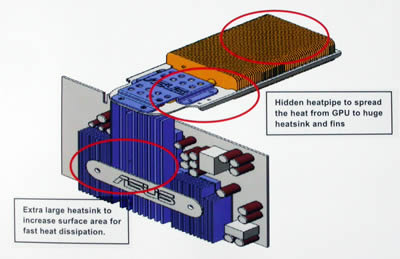 |
| The cooling mechanism in detail... |
The graphics card is now a little bit bigger than in the previous versions of the 6600, though this will not cause any problems with installations, since the heatpipe can be rotated 90° and positioned in one of two ways, so that it fits every user's situation.
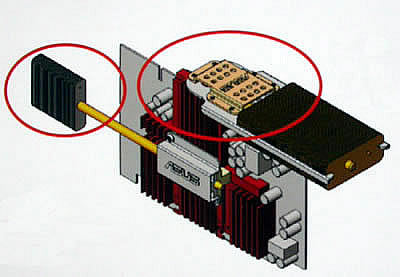 |
| 90° rotation is an option, to avoid any mechanical interference... |
Having rotated the Heatpipe, we took a photo of the rotation mechanism...

- The card itself
As discussed above, the card is a normal sized one, with the exception of the cooling system, which is necessary in order to achieve maximum performance, with no noise and low temperatures.

The heatsink is of copper construction, as expected, in order to maximize heat dissipation and performance... one can clearly discern in the photo below, the ASUS logo in the middle of the heatsink..
 |
| The red stylish heatsink of the Silencer... |
Nothing fancy on the back side of the card, with the two copper covers, protecting the memory modules from overheating.

The output signals are the usual Standard 15-pin D-sub, HDTV-out and DVI-I output.
 |
| Dual DVI-I output and a single D-sub found on the card's rear |
As we've seen in this page, the ASUS N6600GT Silencer, is all about silence and heat dissipation. Do not expect to see the beast-like 6800Ultra performance or anything that "heavy duty" though. Let's move on to the next page and have a look at the test system and on to the tests themselves.
3. Test System
Processor: AMD64 3500+ NewCastle (939 socket)
Case: Antec 1080AMG
Motherboard: ASUS A8N-SLI Deluxe
Memory: 2x512MB Corsair XMS TWINX1024-3200XL Memory
Hard Disk Drive: WD800JD 80GB 7200RPM
DVD Burner: Pioneer DVR-A08XLA
Power Supply: EzCool 550Watt
OS: Microsoft WindowsXP Pro SP2
DirectX: v9

Benchmarking Software
3DMark05,03,01
Codecreatures Benchmark Pro
AquaMark3 v3.0
Farcry v1.3
CounterStrike Source
Doom 3
Thief 3
Ground Control II
4. 3DMark05
 With 3DMark05, Futuremark continues the tradition in its benchmarking software by providing a state-of-the-art Microsoft ® DirectX ® 9 3D performance benchmark.
With 3DMark05, Futuremark continues the tradition in its benchmarking software by providing a state-of-the-art Microsoft ® DirectX ® 9 3D performance benchmark.
3DMark05 is an all new 3DMark version making the most of Microsoft's DirectX
9. The previous version 3DMark03, did a nice introduction into this level
of technology. However
3DMark03 used DirectX 9 specific features in a limited manner, because fully
supporting hardware was rare at the time of its launch. In contrast, 3DMark05
requires DirectX 9 hardware with full support for at least Shader Model 2,
and takes shader usage to never before seen levels.
Just like its predecessors, 3DMark05's point system is set so that at the
moment of release, the high-end VGA cards available in stores can only score
around 5000 3DMarks, whereas the worst card that meets the programs requirements
yields a score of 1000.
Game Test 1 -Return to Proxycon
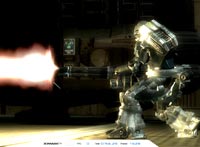 Being the sequel to the "Battle of Proxycon"
from 3DMark03, in "Return to Proxycon" we're once again set in space
and the battle continues as space pirates invade a cargo ship in order to
take control of its valuable cargo.
Being the sequel to the "Battle of Proxycon"
from 3DMark03, in "Return to Proxycon" we're once again set in space
and the battle continues as space pirates invade a cargo ship in order to
take control of its valuable cargo.
This test, tries to simulate a future first-person shooter game with all the high details that entails. The dynamic shadows, high-detailed environment and advanced lighting techniques ensure that under normal circumstances, no recent card can run it with decent frame rates.
Game Test 2 - Firefly Forest
 A forest gets filled with magic fireflies in the night. The moon is nearly full, illuminating the forest with a bluish faint light. The magic fireflies have flickering bright green lights that playfully move around the forest.
A forest gets filled with magic fireflies in the night. The moon is nearly full, illuminating the forest with a bluish faint light. The magic fireflies have flickering bright green lights that playfully move around the forest.
This scene is a nice example of a smaller scale outdoor scene with rich vegetation. Immediate visibility is not so far, and there is a skybox surrounding the whole scene.
A large number of trees with their branches swinging separately, and dense vegetation being dynamically distributed according to the camera movements, make this test the most demanding of the three.
Game Test 3 - Canyon Flight
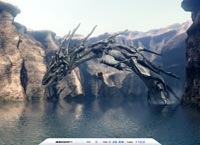 A Jules Verne type airship flies through a canyon guarded
by a dangerous sea monster. The airmen defend their ship using heavy cannons,
but these seem to have no effect on the huge sea monster. Finally the crew
manages a narrow escape using the "last resort" afterburners of
the airship.
A Jules Verne type airship flies through a canyon guarded
by a dangerous sea monster. The airmen defend their ship using heavy cannons,
but these seem to have no effect on the huge sea monster. Finally the crew
manages a narrow escape using the "last resort" afterburners of
the airship.
This scene is fairly complex with large areas of water
reflecting the high canyon walls. The water actually is one of the key points
of interest in this scene. The water not only does realistic looking reflections
and refractions, it has a depth fog, making the sea monster swimming under
the airship actually look deep down in the water. The air in this scene also
uses a volumetric fog, making distant cliffs of the canyon really look far
away.
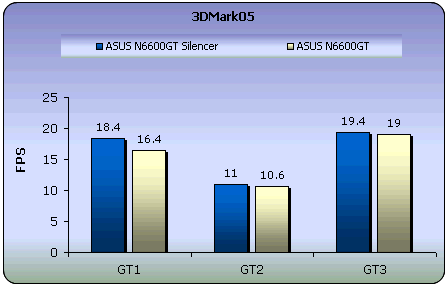
Now let us see how the N6600GT Silencer performed in each test, in comparison to the standard Asus N6600GT. As one can see from the above graph, the results do differ, but not by more than one or two fps.
Final Score
3DMarks on 3DMark05 are now calculated by the following formula:
(Game Test 1 * Game Test 2 * Game Test 3)^0.33 * 250
That's basically the geometric mean of the total frames in each
game multiplied by 250. This means that all game tests are now equal.

Almost 200 marks more were reported for the Silencer 6600GT card compared to the 6600GT standard edition. The 256MB of DD3 sure makes a difference - just 128MB of DD3 for the N6600GT.
5. 3DMark03
 3D Mark is a widely used and accepted benchmark that stresses the DirectX performance of a VGA card. A very strong point of 3DMark is that it's VGA card measuring is does not require any CPU power. So the resulting fps are a good reference a VGA card's rendering performance. For testing the performance of each card we used the 4 game benchmarks 3DMark has.
3D Mark is a widely used and accepted benchmark that stresses the DirectX performance of a VGA card. A very strong point of 3DMark is that it's VGA card measuring is does not require any CPU power. So the resulting fps are a good reference a VGA card's rendering performance. For testing the performance of each card we used the 4 game benchmarks 3DMark has.
3Dmark03 also includes sound and CPU tests as well as some other feature tests.
- Game Test 1 - Wings of Fury (DX7)
 |
This test is a combat flight simulator written for older hardware (DirectX 7). Particles are used a lot in this test - smoke and vapor trails, flak and gunfire, and explosions are produced using point sprites and quads. |
- Game Test 2 - Battle of Proxycon (DX8)
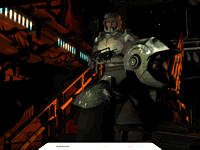 |
This test is a simulation of first person shooter game types. 1.1 and 1.4 Vertex shaders are widely used since all character models are skinned using vertex shaders.This makes this test a good vertex shader comparison for VGA cards. |
- Game Test 3 - Trolls' Lair (DX8)
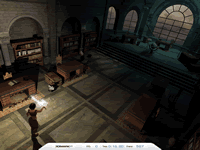 |
This test should be the favorite of all RPG lovers. It is a cut scene of a female warrior facing two malicious trolls. Again the same vertex and pixel processing is used as in game test 2. This test also uses post-processing effects, such as Depth of Field and Bloom effects which are widely used in today's game cut scene sequences. |
- Game Test 4 - Mother Nature (DX9)
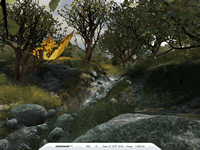 |
Mother nature represents the level of effects and realism that are possible using 2.0 vertex and pixel shaders, plus some other features that DirectX 9 offers. |
- GT Results
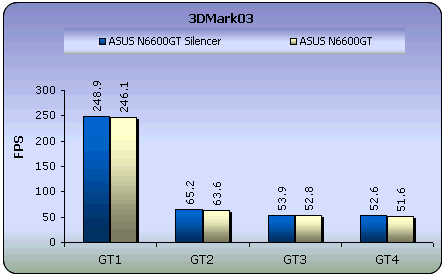
Again, as in the previous benchmark, the Silencer managed to take the lead, although fps differences are considered negligible. Nevertheless, this performance is achieved with 0db as the manufacturer claims, and we confirm this.
- 3DMark Official score
If you test your machine with 3DMark, you can post the results at 3DMark's online result browser. For more information visit futuremark.com.
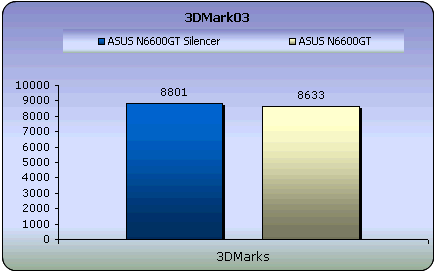
With 168 marks difference, the ASUS N6600GT Silencer claims the title in this benchmark.
6. Codecreatures
 CodeCreatures is a synthetic 3D benchmark that is a good reference for VGA performance comparison. This is a high-end 3D benchmark that also requires DirectX 8 hardware, making a good tool for measuring the potential of DirectX 8 game performance.
CodeCreatures is a synthetic 3D benchmark that is a good reference for VGA performance comparison. This is a high-end 3D benchmark that also requires DirectX 8 hardware, making a good tool for measuring the potential of DirectX 8 game performance.
The Codecreatures benchmark is written with Microsoft's DirectX 8.1 API and incorporates the use of Vertex and PixelShaders popular on next generation 3D accelerators.

The benchmark plays a photo-realistic nature scene and calculates the performance of the graphics adapter by measuring the fps that it can display at 1024x768, 1280x1024 and 1600x1200 resolutions.
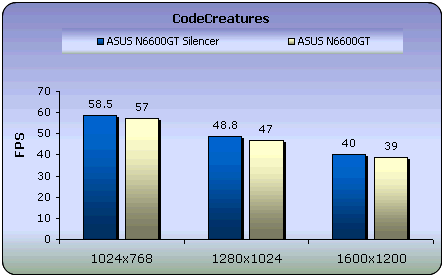
-Codecreatures number
The codecreatures number is the resulting score of the total
benchmarking process and is basically the geometric mean of the three frame
rates multiplied by 100.
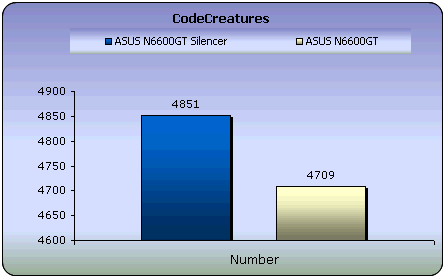
The test uses Vertex and PixelShaders, and the Nvidia PixelShader 3.0 is put to good use. The total amount may not be as high as the high end graphics cards, but is still welcomed and sure to satisfy any demanding user. As for the comparison test, we can see the superiority of the Silencer model to the standard one.
7. Aquamark/3DMark 2001
 Since the majority of today's applications and games are compatible with DirectX 9, the need of benchmark applications that use DX 9 has been brought up. The benchmark uses the 3D engine (Krass engine) of the Aquanox game.
Since the majority of today's applications and games are compatible with DirectX 9, the need of benchmark applications that use DX 9 has been brought up. The benchmark uses the 3D engine (Krass engine) of the Aquanox game.
Aquamark Triscore
The Aquamark Triscore comprises 3 values: the overall system performance, the performance of the graphics system and the CPU performance. Keep in mind that this is not the total result of the tests, but the result of the whole benchmark process including all 9 chapters.

3DMark 2001
 is the predecessor to 3DMark03. It's mainly a directx8.1 benchmark and the score depends a lot on the CPU power of your computer. However for reference use only we decided it'd be best to just leave it in our benchmark list so you can compare the next generation cards with the possibly outdated you have at home.
is the predecessor to 3DMark03. It's mainly a directx8.1 benchmark and the score depends a lot on the CPU power of your computer. However for reference use only we decided it'd be best to just leave it in our benchmark list so you can compare the next generation cards with the possibly outdated you have at home.
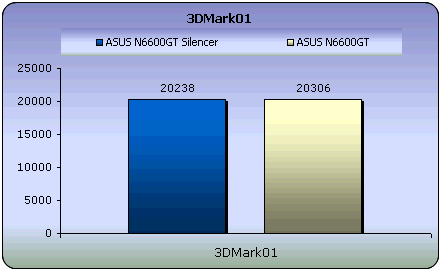
For the first time, the Asus N6600GT standard model, takes the by nearly 100 marks. As discussed above, this test is included merely for comparison reasons, due to it being outdated (dx8).
8. Half Life 2

Half life 2 is no doubt the most anticipated pc game of all times. Gamers keeping the excellence of Half Life 1 in their mind as well as the remarkable E3 demo preview, have been anxiously waiting for the much delayed release of HL2.
 Characters - Advanced facial animation system delivers the most sophisticated in-game characters ever seen. With 40 distinct facial "muscles," human characters convey the full array of human emotion, and respond to the player with fluidity and intelligence.
Characters - Advanced facial animation system delivers the most sophisticated in-game characters ever seen. With 40 distinct facial "muscles," human characters convey the full array of human emotion, and respond to the player with fluidity and intelligence.
Physics - From pebbles to water to 2-ton trucks respond as expected, as they obey the laws of mass, friction, gravity, and buoyancy.
 Graphics
- Source's shader-based renderer, like the one used at Pixar to create movies
such as Toy Story® and Monster's, Inc.®, creates the most beautiful
and realistic environments ever seen in a video game.
Graphics
- Source's shader-based renderer, like the one used at Pixar to create movies
such as Toy Story® and Monster's, Inc.®, creates the most beautiful
and realistic environments ever seen in a video game.
AI - Neither friends nor enemies charge blindly into the fray. They can assess threats, navigate tricky terrain, and fashion weapons from whatever is at hand.
To measure performance we used the Video Stress Test(VST) that is available in the CounterStrike:Source beta available through Steam. We set all the details to the highest level and each time changed the resolution from 800x600 up to 1600x1200.
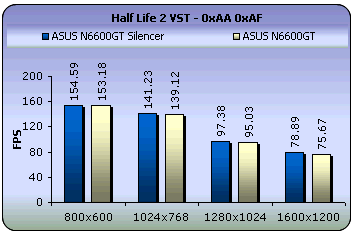
With the AA and AF settings disabled, we took fps measurements at each resolution. The N6600GT was not that far behind the Silencer with only marginal differences in framerate at all resolutions.
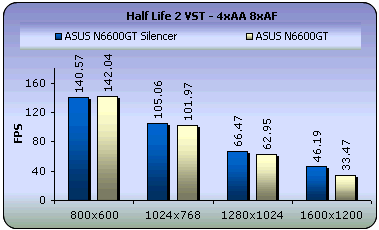
With AA and AF set at 4x and 8x respectively, the N6600GT took the lead, though as the resolution increased, the Silencer nosed ahead. Again, the difference in framerate between the two cards cannot in any way be considered as significant with perhaps the exception of that at 1600x1200, where the Silencer achieved a very satisfying framerate providing excellent playing performance at the highest resolution.
9. Doom 3

A massive demonic invasion has overwhelmed the Union Aerospace Corporations? (UAC) Mars Research Facility leaving only chaos and horror in its wake. As one of the few survivors, you struggle with shock and fear as you fight your way to Hell and back, in an epic clash against pure evil.
Activision made it's miracle again with Doom 3 which is said to be the best-looking game ever, thanks to the brand-new OpenGL graphics engine used to generate its convincingly lifelike, densely atmospheric, and surprisingly expansive environments. If you are a fan of the previous Doom games then you will get many flashbacks with this revision, since you will find reimagined versions of almost every monster from both Doom and Doom II.
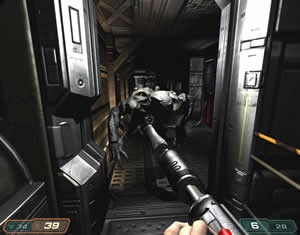
To measure performance on the game we used the timedemo demo1 command from the console (Alt+Ctrl+~).
Enabling the high quality setting and executing the timedemo demo1 command twice for each resolution, we witnessed the following:
First, without Anti-Aliasing and Anisotropic Filtering settings
enabled, we had the following results:

Once more, the Silencer performed slightly better than the N6600GT.
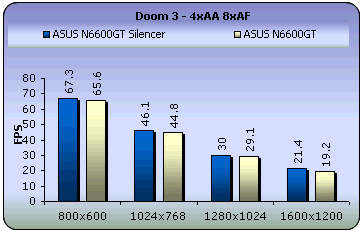
Similar performance as above without AA and AF, just lower frame rates.
10. FarCry

 You are Jack Carver running your own boat charter business in beautiful Micronesia. With a past best left behind you, you'll be focusing on your present assignment: escorting an ambitious journalist named Valerie Cortez to the Island of Cabatu. It seems like a piece of cake, but you'll soon learn: paradise can be hell.
You are Jack Carver running your own boat charter business in beautiful Micronesia. With a past best left behind you, you'll be focusing on your present assignment: escorting an ambitious journalist named Valerie Cortez to the Island of Cabatu. It seems like a piece of cake, but you'll soon learn: paradise can be hell.
Farcry is an awesome First Person Shooter (FPS) based on a last generation 3D engine named as CryEngine. Real-time editing, bump-mapping, static lights, network system, integrated physics system, shaders, shadows and a dynamic music system are just some of the state of-the-art features that the CryEngine offers.
A great advantage and strong point of the CryEngine is its physics system which supports character inverse kinematics, vehicles, rigid bodies, liquid, rag doll, cloth and body effects. All physics seem to be very realistic and you never get bored when facing enemies, since character models have multiple animations that blend in believable ways.
With an integrated shader system and a massive terrain which maximizes
the view distance to 2km, these features make Farcry a perfect action game and
also a referable benchmark to speak of.
- Benchmark Settings
For this game we recorded a custom demo from the start of the Rebellion
stage. We chose an indoor scene in order to avoid getting the CPU bound effect. This will result in slightly higher results since it is also less
GPU intensive, but we can't afford being stuck at 40-50 fps because of our CPU.
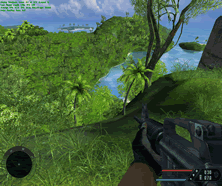
The latest patch (1.3) was used for our tests which updates the
game's graphics engine to use the 3.0 Shader model. This option is only supported
for the 6800 series.

The resolutions we ran the demo under are the following:1024x768,
1280x1024 and 1600x1200.

At all tested resolutions, the Silencer managed to achieve a better framerate than the ASUS N6600GT.
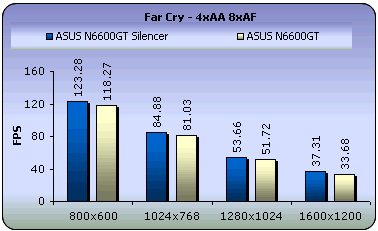
Fairly good frame rates from both cards with AA and AF enabled.
11. Thief 3
 Instead
of Deus Ex from now on we'll be testing our cards using Thief 3. It's based
on the same engine but it's much less GPU intensive and playable by more VGA
cards than
Instead
of Deus Ex from now on we'll be testing our cards using Thief 3. It's based
on the same engine but it's much less GPU intensive and playable by more VGA
cards than 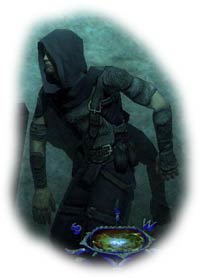 Deus.
Deus.
The game makes severe use of Pixel Shader 1.1 instructions, the bloom effect and stencil shadows to achieve a wonderful result in your screen.
In the game you play the part of Master Thief Garrett who is back to rule out any evil forces using his unique stealth abilities. Deadly Shadows shows what stealth gameplay is all about. This game really gives you the feel of sneaking around and holding your breath when stuck in a sticky situation.
Since there is no official benchmark for the game, we'll do our tests using
a GPU intensive scene from the tutorial-level which we believe that represents
the average fps you'll get when playing the game.
Thief 3 is a torture test for graphics cards. All lower class cards fail to provide stable performance in this benchmark when selecting full details from the settings menu.

This is, as mentioned above, a truly tortuous test, even for the high end graphics cards. A smooth and enjoyable game can only be played comfortably at 800x600, with 62fpd and 60fps from the Silencer and N6600GT respectively.
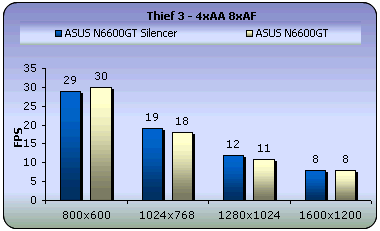
At most, one frame difference in the framerate at any resolution, with the highest framerate of just 30 reported by the N6600GT at 800x600.
12. Colin McRae 2005
 For all you racing fans out there, this test is for you and will represent the Racing game category in our benchmarks.
For all you racing fans out there, this test is for you and will represent the Racing game category in our benchmarks.
From the graphics point of view the first thing you'll
notice in the game is the excellent amount detail of your racing car. High
resolution textures on the car and lighting make it quite impressive. All
the eye candy such as the sun reflection in the virtual camera are still the
same as the older CM versions but motion blur has been added when your card
hits something hard which will happen most often if you're new to the racing
simulation world.

To measure performance on the game we used fraps to get the average fps of the whole 8th stage of UK which is actually the only stage you get to play on the demo.

The only significant difference between the two cards worth mentioning is at the 1280x1024, where the average framerate for the Silencer is 84 compared to 70 for the N6600GT.

By enabling AA and AF, the drop in framerate is by about half, except for 800x600 where the difference is still significant at around 30 frames.
13. Ground Control II
 Ground
Control 2 is an action-oriented game of tactics and warfare. As Captain Jacob
Angelus of the Northern Star Alliance, you will command squads of infantry,
artillery, and air power against the might of the Empire of Terra. Base building
and resource-collecting are replaced with unit control and combat tactics where
your knowledge of the battlefield maneuvers will make the difference in your
fight against a ruthless enemy. Position your troops on hilltops for better
aim or inside buildings and forests for protection as you'll need to use every
inch of terrain to your advantage.
Ground
Control 2 is an action-oriented game of tactics and warfare. As Captain Jacob
Angelus of the Northern Star Alliance, you will command squads of infantry,
artillery, and air power against the might of the Empire of Terra. Base building
and resource-collecting are replaced with unit control and combat tactics where
your knowledge of the battlefield maneuvers will make the difference in your
fight against a ruthless enemy. Position your troops on hilltops for better
aim or inside buildings and forests for protection as you'll need to use every
inch of terrain to your advantage.
For our benchmarks, we used the highest possible settings on the first mission
of the single player game and moved around the camera to get an average frame
rate using fraps.
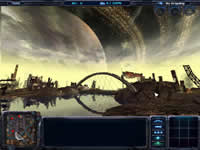
Ground Control II offers really impressive graphics without requiring much GPU power. Click on the picture above to view a screenshot from the game. Check out these excellent water effects!

Again we see that the difference between the two cards is minimal with the Silencer always just slightly ahead.

With AA and AF enabled, the difference between the cards is still insignificant.
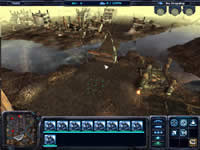
14. Overclocking
No matter your graphics card, there comes a time in your computer's life when it can no longer cope with the latest technology the ever so popular games use. This is one of the main reasons for overclocking your graphics card. Gamers are always looking forward for a little extra boost in terms of framerate. Even though most of the times the boost is far from noticeable, overclocking remains the last resort when you can't afford to buy a brand new VGA card.
 |
Increasing the memory clock too much,
produces the so-called "artifacts". |
The stock clock speeds for the ASUS N6600GT Silencer as reported by ASUS are 500MHz for the GPU and 1GHz (500MHz DDR3) for the memory modules. The Riva Tuner utility reported frequencies of 520 and 1040 for GPU and memory respectively. The reported temperature at idle state is given in the following screenshot taken from the card's properties dialog.
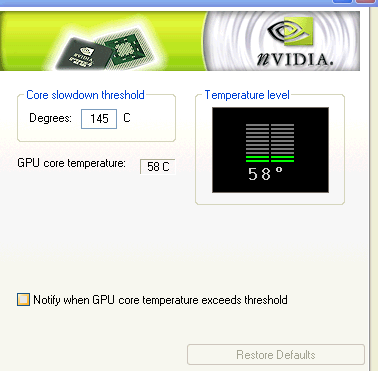
We pushed the card to its limits (570/1170) and we checked the temperature reading after running 3DMark 05 a couple of times...
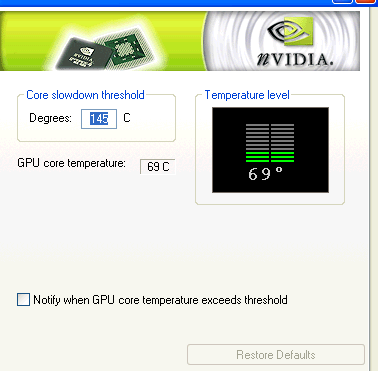
During the OC tests, no artifacts were reported and all tests managed to complete successfully, producing the results shown in the tables below...
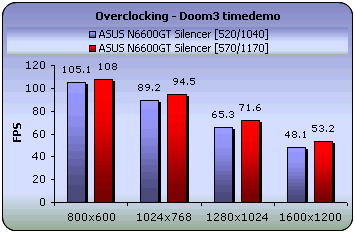

Although the OC performance of this card is limited, it did however manage to produce 5 to 8 frames more with both Doom3 and HL2 OC tests. Good performance for a fanless graphic card.
15. Conclusion
 Another middle line performance card has been introduced into the market by ASUS, the N6600GT Silencer. A standard PCI-E interface, SLI enabled card, the Silencer is sure to please the end user who is looking for good performance and low noise (no noise to be exact), from a graphics card.
Another middle line performance card has been introduced into the market by ASUS, the N6600GT Silencer. A standard PCI-E interface, SLI enabled card, the Silencer is sure to please the end user who is looking for good performance and low noise (no noise to be exact), from a graphics card.
As can be seen from the tests carried out in this review, the main difference between the Silencer and the standard N6600GT model is first and foremost, the fanless design, and secondly the memory modules, with the Silencer having 256MB of DD3 while the N6600GT standard has 128MB of DD3.
The Heatsink and pipeline and fins system will keep the graphics cards temperatures at acceptable levels and even lower than those of the standard N6600GT, even during overclocking. The card will not overclock to extreme levels, but will give out five more frames max, as we showed in the previous pages with the tested OC games.

A slight drawback would be the size of the fins-pipeline assembly, but ASUS has foreseen this and solved any issues by enabling it to rotate 90°, so that installation in any system is easy. Simple as that.
The ASUS N6600GT Silencer retail package is what we usually expect for an ASUS retail box, excellent, containing everything required, including a bundle variety that will not disappoint, with the addition of three of the latest games in full editions. Stylish and extremely practical, the retail box and bundled software is surely a plus for the Silencer graphics card.
At the time of this review, a price had not yet been announced for the ASUS N6600GT Silencer.
Pros:
- Good performance for a 6600
- Low temperature
- No noise
- Great bundle
Cons:
-

Performance: |
|
Value for money: |
|
Overclocking: |
|
Bundle: |
|